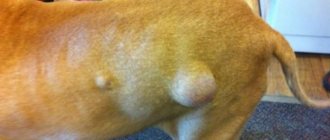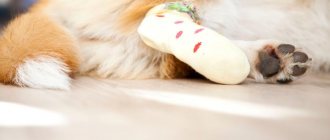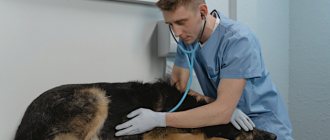If you feel lumps under your dog's skin during palpation, there is no need to panic - there are many possible reasons for the appearance of lumps in your pet. Although malignant tumors do occur in dogs, many tumors that can be felt on the pet’s skin are treatable. A lump or lump could be, for example, an inflamed hair follicle.
The most important thing to do is to keep an eye out for any lumps on your dog's skin and report them to your veterinarian. He will be able to determine whether treatment is necessary.
Why do lumps appear on dogs' paws?
Most lumps on a dog's paws are benign fatty tumors. But these can also be warts, abscesses, sebaceous cysts, mast cell tumors, and malignant neoplasms. They appear for various reasons:
- physiological: a foreign body got into the paw, the dog rubbed a callus while walking on a hard surface;
- traumatic: blow, cut;
- genetic: a feature of a breed or a specific pet;
- as a result of illness: arthritis, allergies.
It is impossible to determine “by eye” the root cause of the compaction. Moreover, due to the fur, the owners do not immediately pay attention to the presence of damage. Therefore, in order to determine why a lump is growing on the pads or on the joint of the pet’s hind/front legs, you need to carefully examine this lump in a veterinary clinic.
Types of cones
The most common bumps in dogs include:
- Fatty tumors (lipomas). They are soft, mobile, and do not cause pain when touched. Occurs in middle-aged and older dogs. They can appear anywhere and are considered a natural part of aging. But most often they are found on the ribs or neck, under the skin. They are diagnosed in representatives of any breed, but more often occur in large dogs that are overweight or prone to rapid weight gain. They do not require treatment unless they cause discomfort.
- A sebaceous cyst is a blocked sebaceous gland, i.e. a small leather bag containing sebum. When it bursts, a white pasty substance comes out. In principle, this formation does not need treatment, but if it begins to increase, it can cause pain. In this case, antibiotics are prescribed to cure the compaction and reduce it.
- A ganglion cyst is a lump caused by the accumulation of joint fluid. Appears on the paws and joints. It is soft to the touch, motionless, and may periodically disappear and reappear. If it doesn’t hurt, it doesn’t require treatment. But if it interferes or looks unsightly, the surgeon can drain the cyst with a needle or remove it during surgery.
- Swelling is usually present in the place where the skin has been exposed to an irritant, infection and the inflammatory process has begun.
- Warts occur as a result of a virus. They are often found in the mouths of young animals.
- An abscess is a collection of pus under the skin. Appears as a result of infection, injury or insect bite.
- Mast cell tumor is considered the most common type of skin cancer in dogs. Most often found in Boxers, Boston Terriers, Labradors, Beagles and Schnauzers. Treatment will depend on the size and location of the tumor and may include surgery, radiation therapy, or chemotherapy.
- A callus develops if, for some reason, your pet's body weight is unevenly distributed. Then some legs end up being loaded more than others.
- Joint inflammation occurs in sporting animals. For example, greyhounds that compete in track events develop calluses on the balls of their feet.
Important! 8 out of 10 lumps on dogs are definitely not cancerous. But you won’t be able to find out without a diagnosis, so if you notice a tumor, be sure to visit a veterinarian.
Reds
Red color may be a sign of accumulation of bloody contents in the lump. Interdigital cysts are red. They most often form on the front legs. A dog with such a bump will limp in pain, especially when walking on uneven surfaces, and may also lick or chew its paw. The cause of a cyst is any irritation or damage to the hairy skin of the foot. This happens most often in:
- pets with short and coarse hair, such as English bulldogs, Great Danes, basset hounds, mastiffs, bull terriers and boxers;
- dogs with wide paws, in which part of the body weight falls on the interdigital folds. Breeds with this foot type include Labradors, English bulldogs, German shepherds and Pekingese dogs;
- obese animals - their excess weight puts more pressure on the fingers when walking;
- dogs with arthritis or joint problems.
A red and swollen surface indicates inflammation that occurs under the skin.
It can be the result of an allergy, a bacterial or fungal infection, or an insect bite. Also, a swollen red inflamed lump can be a sebaceous cyst. Most often it won't cause problems as long as it doesn't itch.
A histocytoma is a benign lump that looks like a red button. Diameter - from 2.5 cm. It is an abnormal growth of skin cells - histocytes. It is found on the head, limbs, and neck of young dogs of the following breeds: American pit bull terriers, Staffordshire terriers, Scottish terriers, greyhounds, Boston terriers, bulldogs. It goes away quite quickly without special treatment - within 3 months.
Important! In order not to miss the moment when your pet develops a tumor, just remember to run your hand over the skin after a walk. This way you will promptly remove ticks if you accidentally pick them up and inspect the surface.
Pink
Pink color is a sign of any non-inflammatory tumor. This lump can be soft or hard. For example, lipoma (fat). It is round pink and soft to the touch. It grows slowly and does not spread to other tissues. Lipoma is diagnosed by aspiration. You may not need to do anything to it, but it is necessary for a doctor to examine this formation.
Black
Black color is a sign of a wart. But melanomas can also be pigmented. And this is one of the most serious types of cancer. Melanomas appear as dark bumps on the paws or face. But they can also occur in the nail bed, toe or paw. Characterized by slow growth. The exact cause of melanomas is not clear, but it is believed to be related to ultraviolet rays. The diameter of the formation is about 6 mm. It is treated surgically.
Diagnostic measures
Diagnostics will help to find out the cause of the problem of interdigital dermatitis. To contact a veterinarian, you will need to spend 3 days without treating problem areas on the skin with anything.
To diagnose the disease, a blood test is prescribed.
The veterinarian will first order the following tests:
- smear from the damaged area;
- scraping to identify parasites;
- sowing for fungal flora.
Additionally, the following may be assigned:
- x-ray or computed tomography;
- blood tests;
- if the paws are positioned incorrectly, consult an orthopedist;
- if you suspect cancer, consult an oncologist.
What to do at home
If the mass is between the fingers (interdigital cyst), the doctor will need to take a sample of the skin to determine the type of bacteria causing the inflammation. For treatment at home, treat your paws with antibacterial shampoo. The choice of shampoos is always very wide. These are “Pchelodar antibacterial”, “BioFloR sulfur with anti-inflammatory effect”, “antimicrobial ApiSan with chlorhexidine”, “Okvet medicinal with chlorhexidine”. All drugs have an antimicrobial and wound-healing effect.
Rules for using shampoo:
- The affected area of skin should be washed to remove dirt and crusts using water and a cotton swab.
- Then apply shampoo to the treated surface. You can massage, but do not rub, so as not to damage the inflamed skin.
- Exposure time 2–5 minutes. After this, rinse with warm water and dry the hair. If a hairdryer is used, the air should be cool, because inflamed skin is very sensitive to irritants and temperature.
- A purulent lump (abscess), if it leaks liquid, should be washed with an antibacterial solution.
Did you know? Shampoos with natural ingredients are not necessarily better than others. For example, lemon can irritate hair follicles and skin. And mint, instead of having a calming effect, can cause allergies. Therefore, when choosing a pet wash, pay attention to whether it can be used on animals.
Shampoos are used as an addition to the main therapy. They are not a separate drug. Therefore, if the swelling of the paw is severe, then anti-inflammatory drugs are definitely needed to reduce it. Use Carprofen 4 mg/kg 1 time per day, Simalgeks 2 mg/kg 1 time per day or another medicine. To relieve pain, take Rimadyl 4 mg/kg or Analgin, 1/2 tablet for a small dog or 1 tablet for a large one.
For successful treatment, an accurate diagnosis of the pathology that caused the lump is necessary. Otherwise, it may begin to grow again and cause scarring and permanent difficulty walking.
Prevention of interdigital dermatitis;
Preventive measures for interdigital dermatitis include:
- Thoroughly wash paws after walking under running water
- Treatment of even the slightest damage to the skin of the paws
- Diet adherence
- Limiting contact with chemicals
- Timely treatment against parasites
Prices for appointments in our network of veterinary clinics
| Name of veterinary services | Unit | Price, rub |
| ⭐ Initial appointment | 1 animal | 400 |
| ⭐ Repeated appointment | 1 animal | 250 |
| Initial appointment with a specialist | 1 animal | 1100 |
| Consultation without an animal | — | 550 |
| Consultation with a doctor based on test results | 1 PC. | 400 |
| Weighing animals | 1 animal | For free |
| Additional fixation for aggressive animal behavior | 1 animal | 700 |











